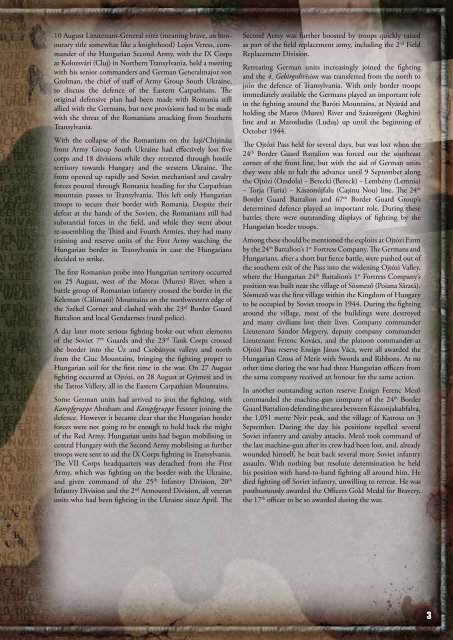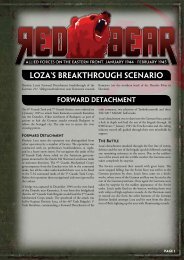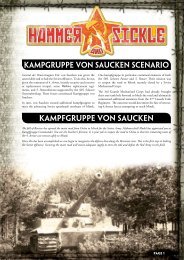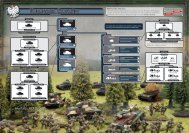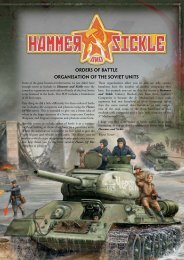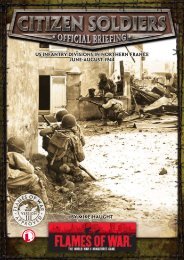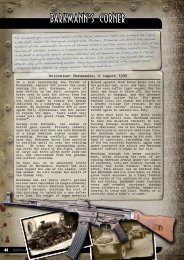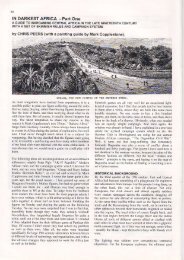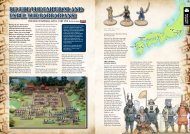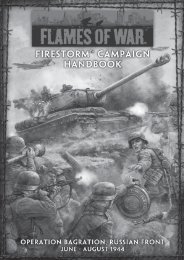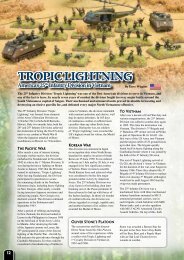Hungarian Infantry (PDF)... - Flames of War
Hungarian Infantry (PDF)... - Flames of War
Hungarian Infantry (PDF)... - Flames of War
You also want an ePaper? Increase the reach of your titles
YUMPU automatically turns print PDFs into web optimized ePapers that Google loves.
10 August Lieutenant-General vitéz (meaning brave, an honourary<br />
title somewhat like a knighthood) Lojos Veress, commander<br />
<strong>of</strong> the <strong>Hungarian</strong> Second Army, with the IX Corps<br />
at Kolozsvári (Cluj) in Northern Transylvania, held a meeting<br />
with his senior commanders and German Generalmajor von<br />
Grolman, the chief <strong>of</strong> staff <strong>of</strong> Army Group South Ukraine,<br />
to discuss the defence <strong>of</strong> the Eastern Carpathians. The<br />
original defensive plan had been made with Romania still<br />
allied with the Germans, but new provisions had to be made<br />
with the threat <strong>of</strong> the Romanians attacking from Southern<br />
Transylvania.<br />
With the collapse <strong>of</strong> the Romanians on the Iaşi/Chişinău<br />
front Army Group South Ukraine had effectively lost five<br />
corps and 18 divisions while they retreated through hostile<br />
territory towards Hungary and the western Ukraine. The<br />
front opened up rapidly and Soviet mechanised and cavalry<br />
forces poured through Romania heading for the Carpathian<br />
mountain passes to Transylvania. This left only <strong>Hungarian</strong><br />
troops to secure their border with Romania. Despite their<br />
defeat at the hands <strong>of</strong> the Soviets, the Romanians still had<br />
substantial forces in the field, and while they went about<br />
re-assembling the Third and Fourth Armies, they had many<br />
training and reserve units <strong>of</strong> the First Army watching the<br />
<strong>Hungarian</strong> border in Transylvania in case the <strong>Hungarian</strong>s<br />
decided to strike.<br />
The first Romanian probe into <strong>Hungarian</strong> territory occurred<br />
on 25 August, west <strong>of</strong> the Moras (Mures) River, when a<br />
battle group <strong>of</strong> Romanian infantry crossed the border in the<br />
Keleman (Călimani) Mountains on the northwestern edge <strong>of</strong><br />
the Székel Corner and clashed with the 23 rd Border Guard<br />
Battalion and local Gendarmes (rural police).<br />
A day later more serious fighting broke out when elements<br />
<strong>of</strong> the Soviet 7 th Guards and the 23 rd Tank Corps crossed<br />
the border into the Úz and Csobányos valleys and north<br />
from the Ciuc Mountains, bringing the fighting proper to<br />
<strong>Hungarian</strong> soil for the first time in the war. On 27 August<br />
fighting occurred at Ojtózi, on 28 August at Gyimesi and in<br />
the Tatros Vallery, all in the Eastern Carpathian Mountains.<br />
Some German units had arrived to join the fighting, with<br />
Kampfgruppe Abraham and Kampfgruppe Fessner joining the<br />
defence. However it became clear that the <strong>Hungarian</strong> border<br />
forces were not going to be enough to hold back the might<br />
<strong>of</strong> the Red Army. <strong>Hungarian</strong> units had begun mobilising in<br />
central Hungary with the Second Army mobilising as further<br />
troops were sent to aid the IX Corps fighting in Transylvania.<br />
The VII Corps headquarters was detached from the First<br />
Army, which was fighting on the border with the Ukraine,<br />
and given command <strong>of</strong> the 25 th <strong>Infantry</strong> Division, 20 th<br />
<strong>Infantry</strong> Division and the 2 nd Armoured Division, all veteran<br />
units who had been fighting in the Ukraine since April. The<br />
Second Army was further boosted by troops quickly raised<br />
as part <strong>of</strong> the field replacement army, including the 2 nd Field<br />
Replacement Division.<br />
Retreating German units increasingly joined the fighting<br />
and the 4. Gebirgsdivision was transferred from the north to<br />
join the defence <strong>of</strong> Transylvania. With only border troops<br />
immediately available the Germans played an important role<br />
in the fighting around the Baróti Mountains, at Nyárád and<br />
holding the Maros (Mures) River and Szászrégent (Reghin)<br />
line and at Marosludas (Luduş) up until the beginning <strong>of</strong><br />
October 1944.<br />
The Ojtózi Pass held for several days, but was lost when the<br />
24 th Border Guard Battalion was forced out the southeast<br />
corner <strong>of</strong> the front line, but with the aid <strong>of</strong> German units<br />
they were able to halt the advance until 9 September along<br />
the Ojtózi (Ozsdola) − Berecki (Bereck) − Lemhény (Lemnia)<br />
− Torja (Turia) − Kászonújfalu (Caşinu Nou) line. The 24 th<br />
Border Guard Battalion and 67 th Border Guard Group’s<br />
determined defence played an important role. During these<br />
battles there were outstanding displays <strong>of</strong> fighting by the<br />
<strong>Hungarian</strong> border troops.<br />
Among these should be mentioned the exploits at Ojtózi Farm<br />
by the 24 th Battalion’s 1 st Fortress Company. The Germans and<br />
<strong>Hungarian</strong>s, after a short but fierce battle, were pushed out <strong>of</strong><br />
the southern exit <strong>of</strong> the Pass into the widening Ojtózi Valley,<br />
where the <strong>Hungarian</strong> 24 th Battalion’s 1 st Fortress Company’s<br />
position was built near the village <strong>of</strong> Sósmező (Poiana Sărată).<br />
Sósmező was the first village within the Kingdom <strong>of</strong> Hungary<br />
to be occupied by Soviet troops in 1944. During the fighting<br />
around the village, most <strong>of</strong> the buildings were destroyed<br />
and many civilians lost their lives. Company commander<br />
Lieutenant Sándor Megyery, deputy company commander<br />
Lieutenant Ferenc Kovács, and the platoon commander at<br />
Ojtózi Pass reserve Ensign János Vácz, were all awarded the<br />
<strong>Hungarian</strong> Cross <strong>of</strong> Merit with Swords and Ribbons. At no<br />
other time during the war had three <strong>Hungarian</strong> <strong>of</strong>ficers from<br />
the same company received an honour for the same action.<br />
In another outstanding action reserve Ensign Ferenc Mező<br />
commanded the machine-gun company <strong>of</strong> the 24 th Border<br />
Guard Battalion defending the area between Kászonjakabfalva,<br />
the 1,051 metre Nyir peak, and the village <strong>of</strong> Katrosa on 3<br />
September. During the day his positions repelled several<br />
Soviet infantry and cavalry attacks. Mező took command <strong>of</strong><br />
the last machine-gun after its crew had been lost, and, already<br />
wounded himself, he beat back several more Soviet infantry<br />
assaults. With nothing but resolute determination he held<br />
his position with hand-to-hand fighting all around him. He<br />
died fighting <strong>of</strong>f Soviet infantry, unwilling to retreat. He was<br />
posthumously awarded the Officers Gold Medal for Bravery,<br />
the 17 th <strong>of</strong>ficer to be so awarded during the war.


